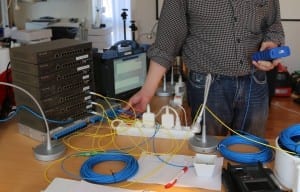IPTV Testing – Kurser – Duration Two days
This course deals with the valid standards within the area of IPTV, intended for testing network installations, with regard to parameters like jitter, delay,
QOS etc.
This course deals with the valid standards within the area of IPTV, intended for testing network installations, with regard to parameters like jitter, delay,
QOS etc.
Are you running out of fiber, or bandwidth. Then using WDM technology, you can increase both. Its like takeing a two fiber installation and changing it to a 36 fiber installation, or even more.
During the two days, we first build a CWDM installation, with 40Km of fiber between the end stations. This is upgraded to a DWDM installation. And later the DWDM is put on the CWDM so all is running at the same time. We install an OADM Optical Add Drop Multiplexer in the middle so me can drop or and a single channel. We use an OTDR, WDM Power Meters, and broadband lightsource together with an OSA(Optical Spectrum Analyser) The course is a combination of theory and labs, giving a good understanding of wavelengths, signal widths and attenuation. During the two days you have to mount nearly 100 patch cords.

If you need to know something about:
Optical fiber technology
The difference between single mode and multi mode
The difference between IL and RL
How different types of connectors look like
How to build a local network
A backbone installation
How to implement FTTH
Then I can arrange lectures, suitable for your needs. The content may be more or less technical, showing different kinds of equipment, such as:
Fiber
Cables
Plugs and sockets
Tubes and ducts
Splicers
Fiber tools
This site uses cookies. By continuing to browse the site, you are agreeing to our use of cookies.
OKWe may request cookies to be set on your device. We use cookies to let us know when you visit our websites, how you interact with us, to enrich your user experience, and to customize your relationship with our website.
Click on the different category headings to find out more. You can also change some of your preferences. Note that blocking some types of cookies may impact your experience on our websites and the services we are able to offer.
These cookies are strictly necessary to provide you with services available through our website and to use some of its features.
Because these cookies are strictly necessary to deliver the website, refuseing them will have impact how our site functions. You always can block or delete cookies by changing your browser settings and force blocking all cookies on this website. But this will always prompt you to accept/refuse cookies when revisiting our site.
We fully respect if you want to refuse cookies but to avoid asking you again and again kindly allow us to store a cookie for that. You are free to opt out any time or opt in for other cookies to get a better experience. If you refuse cookies we will remove all set cookies in our domain.
We provide you with a list of stored cookies on your computer in our domain so you can check what we stored. Due to security reasons we are not able to show or modify cookies from other domains. You can check these in your browser security settings.
We also use different external services like Google Webfonts, Google Maps, and external Video providers. Since these providers may collect personal data like your IP address we allow you to block them here. Please be aware that this might heavily reduce the functionality and appearance of our site. Changes will take effect once you reload the page.
Google Webfont Settings:
Google Map Settings:
Google reCaptcha Settings:
Vimeo and Youtube video embeds:
You can read about our cookies and privacy settings in detail on our Privacy Policy Page.
Privatlivspolitik